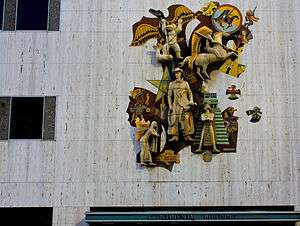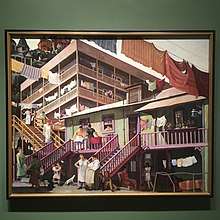Millard Sheets
Millard Owen Sheets (June 24, 1907 – March 31, 1989) was an American artist, teacher, and architectural designer, who was one of the earliest of the California Scene Painting artists. Many of his large-scale building-mounted mosaics from the mid-20th century are still extant in Southern California.[1]
Millard Sheets | |
|---|---|
| Born | Millard Owen Sheets June 24, 1907 Pomona, California, U.S. |
| Died | March 31, 1989 (aged 81) Gualala, California, U.S. |
| Nationality | American |
| Education | Chouinard Art Institute |
| Known for | painting, sculpture, mosaics |
Early life and education
Millard Sheets was born June 24, 1907 and grew up in the Pomona Valley, east of Los Angeles.[2][3] He attended the Chouinard Art Institute and studied with painters Frank Tolles Chamberlin and Clarence Hinkle.[4] While he was still a teenager, his watercolors were accepted for exhibition in the annual California Water Color Society show. By the age of 19, he was elected into membership. The following year he was hired to teach watercolor painting even before his graduation from Chouinard.
Post-educational career
In 1929 he won second prize in the Texas Wildflowers Competitive Exhibitions, and the generous award[5] allowed Sheets to travel to Europe for a year to further his art education.[6] By the early 1930s he began to achieve national recognition as a prominent American artist. He was exhibiting in Paris, New York City, Pittsburgh, Chicago, Houston, St. Louis, San Antonio, San Francisco, Washington D.C., Baltimore, and many other cities throughout the United States. In Los Angeles he was recognized as the leading figure and driving force behind the California Style watercolor movement.
Between 1935 and 1941, his recognition, awards, and output increased, winning him repeated mention in Art Digest and a color reproduction of his work in the book Eyes on America. In 1935 at age 28, he was the subject of a monograph published in Los Angeles. His art sales enabled him to travel again to Europe, Central America, and Hawaii, where he painted on location. Although his watercolor techniques during this period ranged from very tight to very loose, a consistent, he nevertheless exhibited a personal style.

During World War II, he was an artist-correspondent for Life and the United States Army Air Forces in India and Burma. Many of his works from this period document the scenes of famine, war, and death that he witnessed. His wartime experience also informed his post-war art for a number of years, where while painting in California and Mexico in the 1940s his work followed dark hues and depressing subjects. After the 1950s his style shifted toward brighter colors and subjects from his worldwide travels.
Watercolor and oil painting were only part of Sheets's art career. Through his teaching at Chouinard Art Institute, Otis Art Institute, Scripps College and other institutions, hundreds of artists learned how to paint, and were then guided into art careers. He directed the art exhibition at the Los Angeles County Fair for many years and brought world-class work to Southern California. During the Great Depression, he joined forces with Edward Bruce to hire artists for the Public Works of Art Project, the first New Deal art project. In 1946, he served as a president of the California Water Color Society. In later years, he worked as an architect, illustrator, muralist, printmaker, and art exhibition juror.
Outside of California, he took on commissions for the Detroit Public Library, the Mayo Clinic, the dome of the National Shrine, the University of Notre Dame library, the Hilton Hotel in Honolulu, and the Mercantile National Bank in Dallas.
In 1953, Sheets was appointed director of Otis Art Institute (later named Otis College of Art and Design).[7] Under his leadership, the school's academic program was restructured to offer BFA and MFA degrees, and a ceramics department was created, headed by Peter Voulkos. During that time, a ceramics building, gallery, library, and studio wing were completed. By the time Sheets left Otis in 1960, the form and direction of the college had changed dramatically. In 1997, the library at Otis College was named after him.
Mosaic murals at Home Savings Bank branches
In the late 1950s, Sheets was commissioned by Howard F. Ahmanson to design Home Savings Bank branches throughout Southern California that would serve as community landmarks by expressing "community values" or presenting "a celebratory version of the community history." To accomplish this goal, Sheets designed his branch buildings with exterior façades containing large mosaic works depicting local heritage.[1]
The Ahmanson commissions multiplied to include more than 40 branch buildings after the initial 1955 commission. Millard Sheets resigned his teaching position at Scripps College and established the Sheets Studio in Claremont, California, employing a series of artists.[1] Three of the most notable artists were Sue Lautmann Hertel, Nancy Colbath, and Denis O'Connor, whose names/initials were the only ones included on the artworks along with those of Millard Sheets.[8][9]
Sheets produced these mosaics as commercial commissions, and according to K. M. Williamson of Public Art in Public Places he rarely titled them.[10] Nevertheless, they are now considered official public art and are titled by their image(s) or theme.[8] Although they enjoy some protections under the California Arts Preservation Act, many have been destroyed.[1] The following Sheets Studio mosaics in Southern California have survived deterioration and demolition and are archived by Public Art in Public Places:
- (1962) Early Pomona Family, Pomona, California, United States
- (1968, 1982) Indians and Yuccas, Claremont, California, United States
- (1971/2013) Mi Casa Es Su Casa , Beverly Hills, California, United States
- (1979) Scenes of the Old West, Buena Park, California, United States
- (1980) Redlands Heritage, Redlands, California, United States
Millard Sheets Art Center
The Millard Sheets Art Center first began as the Fine Arts Program of the Los Angeles County Fair in 1922. The 20,000+ square-foot art center was built in 1937 by the Works Progress Administration to house the program, the first major gallery dedicated solely to art in Los Angeles County. Each year, the gallery provided visitors to the Los Angeles County Fair with access to art work found throughout the world. In 1994 the building was dedicated to Millard Sheets and in 2013 was identified by Fairplex as the home for year-round art education and exhibitions and is currently a part of The Learning Centers at Fairplex.
Other notable works
- (1934) Southern California landscape – Dining room wall painting for homeowners Fred H. and Bessie Ranke in the Hollywood Hills, moved in 2014 to the Huntington Library, Art Collections, and Botanical Gardens in San Marino, CA.[11]
- (1934) Tenement Flats - A painting in the collection of the Smithsonian American Art Museum done during the Depression for the Public Works of Art Project and chosen to hang in the White House to show President Roosevelt's commitment to the arts and the American people.
- (1939) Early California - Three relief panels, stainless steel and enamel, installed at Mark Keppel High School, Alhambra, California
- (1943) The Negro's Contribution in the Social and Cultural Development of America - murals on first floor of the Main Interior Building, 1849 C St. NW, Washington, DC
- (1961) Scottish Rite Masonic Temple on Wilshire Boulevard in Los Angeles, designed and completed in 1961. For decades the building was considered "one of Los Angeles's most notorious real estate white elephants." [12] Though largely vacant since 1994, it was used as a location for the 2004 adventure film National Treasure starring Nicolas Cage, concerning a fictional long-running Masonic conspiracy.[13] It was refurbished in 2016 to house the Marciano Art Foundation museum.
- (1961) Murals (one 24 ft., one 36 ft.) for the Palomare Room restaurant in Buffums department store, Pomona Mall in Sheets’ native Pomona, portraying early Spanish settlement of the Pomona Valley. Sheets also designed the pedestrian mall itself.[14][15]
- (1963) Three Scenes From Shakespeare - A building-mounted mosaic of three vignettes from Antony and Cleopatra, Romeo and Juliet, and Macbeth, Garrison Theater, Scripps College, Claremont, California
- (1964) Word of Life mural - A large mural on the side of the Hesburgh Library at the University of Notre Dame in South Bend, Indiana. Commonly known among football fans as Touchdown Jesus because of its depiction of Jesus with upraised arms, similar to the official's signal for a touchdown.


References
- Arenson, Adam (2018). Banking on Beauty: Millard Sheets and Midcentury Commercial Architecture in California. Austiin, Texas: University of Texas Press. pp. 2, 131. ISBN 978-1-4773-1529-3.
- "Artists: Millard Sheets". Smithsonian American Art Museum. Retrieved 2020-07-21.
- Kendall, John (1989-04-02). "Millard Owen Sheets, 81; Artist, Designer and Teacher". Los Angeles Times. Retrieved 2020-07-21.
- Blake, Janet (2012). ""In Love with Painting": The Life and Art of Clarence Hinkle". www.tfaoi.com. Retrieved 2020-07-21.
- "Wildflower Competitive Exhibitions" Archived 2013-06-20 at the Wayback Machine. San Antonio Art League Museum website. Retrieved Jan. 31, 2016.
- "Wildflower Competitive Exhibitions: Millard Sheets" Archived 2015-12-19 at the Wayback Machine. San Antonio Art League Museum website. Retrieved Jan. 31, 2016.
- "Millard Sheets Named Art Institute Director," Los Angeles Times, August 20, 1953, A1.
- Williamson, K. M. (July 20, 2020). ""Indians and Yuccas" (1968, 1982) by Millard Sheets, Denis O'Connor, and Sheets Studio artists". Public Art in Public Places. Retrieved July 20, 2020.
- Williamson, K. M. (July 20, 2020). ""Scenes of the Old West" (c. 1979) by Millard Sheets, Denis O'Connor, Susan Lautmann Hertel, and Sheets Studio artists". Public Art in Public Places (published November 2018). Retrieved July 20, 2020.
- Williamson, K. M. (April 21, 2020). ""Mi Casa Es Su Casa" (1971/2013) by Millard Sheets, Sheets Studio artists". Public Art in Public Places. Retrieved April 24, 2020.
- Karen Wada, Millard Sheets mural moving to the Huntington Archived 2014-11-05 at the Wayback Machine, LA Observed, November 4, 2014
- L.A.'s art world eagerly awaits 2017 opening of Marciano muse Archived 2016-12-31 at the Wayback Machine by Deborah Vankin, Los Angeles Times, Dec. 30, 2016.
- Bluejeans moguls to turn Masonic lodge in L.A. into a private museum Archived 2013-07-31 at the Wayback Machine by Roger Vincent, Los Angeles Times, July 24, 2013.
- https://www.dailybulletin.com/2018/12/06/buffums-murals-by-millard-sheets-return-to-pomona/
- https://www.newspapers.com/clip/55967734/millard-sheets-murals-commissioned-for/
External links
- Millard Sheets: A Legacy of Art and Architecture (complete PDF booklet about his work created for the Getty Pacific Standard Time project by the Los Angeles Conservancy)
- Interview of Millard Sheets, part of Los Angeles Art Community - Group Portrait interview series, Center for Oral History Research, UCLA Library Special Collections, University of California, Los Angeles.
- List of artworks by Millard Sheets at the Smithsonian American Art Museum
- "1934: A New Deal for Artists" (exhibition on the Great Depression featuring Millard Sheets and his contemporaries), Smithsonian American Art Museum
- California Watercolor
- List of artworks by Millard Sheets at the Ruth Chandler Wiliamson Gallery of Scripps College
- Millard Sheets Papers at the Smithsonian's Archives of American Art
- Panorama of the Pomona Valley, 1965 on view at the American Museum of Ceramic Art